

The word "propaganda" holds strongly unpleasant connotations, because it was so ruthlessly employed by the leaders of fascist and communist governments for media campaigns to promote what were extremely brutal regimes. In Nazi Germany (1933-1945), Dr. Joseph Goebbels (1997-1945) was in charge of propaganda. His official title was Minister of Propaganda and National Enlightenment. His first goal: to ensure that no one in Germany saw or read anything hostile or damaging to the Nazi Party. This involved censoring works and labeling art of the wrong aesthetic as degenerate; even to the burning of offending books on bonfires, to the imprisonment and murder of those expressing offending views, along with anyone associated with them. Goebbels' second goal: to ensure that the views of the Nazis were conveyed in the most persuasive manner possible — glorifying Hitler, sympathizing with Germans for their mistreatment by other countries after World War II, attacking Jews, Communists, homosexuals, Gypsies, and anyone else they didn't like. To this end the Nazis orchestrated and distributed a broad array of persuasive and intimidating media, held massive rallies presenting stirring speeches and spectacles, and endorsed art displaying the fascist aesthetic.
Examples:
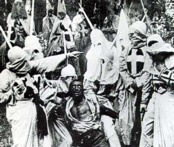
![]()
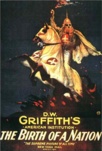
D.W. Griffith (American, 1875-1948), producer and director, The Birth of a Nation, 1915, silent film, 187 minutes. Do these masked men bring justice or terror? This poster (on the left) advertised an early full-length motion picture that dramatized an American Civil War narrative. The Birth of a Nation emphasized a xenophobic portrayal of blacks, and justified violence against them by the Ku Klux Klan. In the scene from which this still (on the right) was taken, the "renegade Negro," Gus, played by white actor Walter Long in blackface, is killed following a "trial" conducted by the Klan. Whether Griffith intended it as propaganda or not, it effectively served as such for a revival of the KKK. See cinema and ugly.
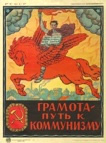
Union of Soviet Socialist Republics, Literacy is the path to communism, 1920, Gosizdat, publisher, Moscow, lithographed poster, 72 x 54 cm. See Russian art.
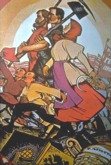
Union of Soviet Socialist Republics, On
the ruins of capitalism toward a world-wide brotherhood of workers,
1930s?, poster. See socialist realism.
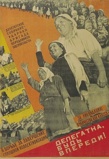
Brigade KGK (a collaboration of Vera Adamnova Gitsevich (1897-1976), Viktor Borisovich Konetsky (1909-?) and B. Knoblok),
Female delegate, stand to the fore!, 1931, Ogiz-Izogiz, publisher, Moscow and Leningrad, lithographed poster, 99 x 69 cm.

German, Health, child protection, fighting poverty, aiding travellers, community, helping mothers: These are the tasks of the National Socialist People's Charity. Become a member!, c. 1930s, poster, German Federal Archive, Koblenz. Three years before Hitler came to power, this poster promoted a Nazi charity known as the NSV. Is it impossible to think of Nazis as charitable? This shows you to what dizzying heights of persuasion propaganda can aspire. See fascist aesthetic.
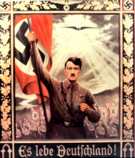
German, Long live Germany!, after 1936, poster, German Federal Archive, Koblenz. This portrait of Hitler casts him as a sainted hero. A Holy Spirit-like / dove-like eagle flies in the radiant glow above an idealized Hitler, reminiscent of Baroque paintings of Christ in scenes with John the Baptist. See flag.
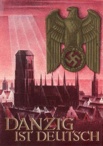
German, Danzig is German (Danzig ist Deutsch), late 1939, postcard. At the end of World War I the Treaty of Versailles removed the city of Danzig (today the Polish city of Gdansk) from what became the German republic. Danzig became a free-state under Polish tutelage. Hitler's army invaded Poland in 1939 in a quest to re-establish Greater Germany. This postcard was produced to commemorate the Nazis' absorption of Danzig. By emphasizing the sun shining through the clouds onto the city's cathedral, the designer of this propaganda suggests that even the heavens approve of Hitler's conquests.
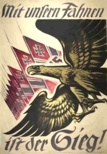
German, Our Flags are Victory! (Mit unfern Fahnen ist der Sieg!), 1940, poster. 650,000 copies were distributed by the Nazis. See flag.
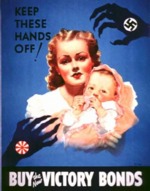
G.K.Odell (Canadian), Keep these Hands Off! Buy the New Victory Bonds,
c. 1941-45, poster commissioned by the Canadian government; National Archives and Records
Administration, Washington, DC. Dark, claw-like hands marked with the Nazi swastika and Japan's rising sun threaten the safety of a mother and infant. Is it likely Odell intended an analogue to a Madonna?
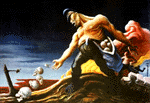
Thomas Hart Benton (American, 1889-1975),
The
Sowers, 1942, tempera,
for a poster commissioned by USA government, National Archives and Records Administration,
Washington, DC. This is one of a series of eight paintings Benton
made to "support the war effort." Here he portrayed
the violence and barbarity of fascism, representing the enemy
as a bulky, brutish monster tossing human skulls onto the ground.
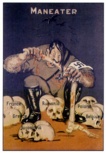
British, Maneater, c. 1942-43, poster. This portrayal of Hitler is comparable to the figure in Benton's painting, and to depictions in editorial cartoons.
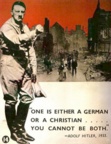
British, One is Either a German or a Christian, c. 1942-43, poster, Number 14 in a series. Compare this to the previous image. Rather than the cartoonish allegories seen in the previous two pictures, this monstrous scene might be just as frightening: an actual photograph of Adolf Hitler overlapping another of bombed-out London, accompanied by a horrifying quote of the Nazi fuhrer.
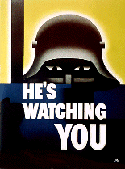
Glenn Grohe (American, 1912-1956), He`s Watching
You, c. 1942, gouache
on cardboard, poster commissioned
by USA government, National Archives and Records Administration,
Washington, DC.

Ben Shahn (American, 1898-1969), Office of War Information, and the U. S. Government Printing Office, This is Nazi brutality : Radio Berlin... — all men of Lidice — Czechoslovakia — have been shot: the women deported to a concentration camp: the children sent to appropriate centers — the name of the village was immediately abolished. 6/11/42/115P, 1942, 38 x 28.25 inches, Minneapolis Public Library, MN.
![]()
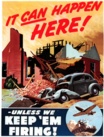
American, It Can Happen Here!, c. 1942-45, poster.
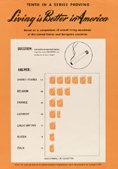
National Association of Manufacturers (U.S.A.), Tenth in a series proving : Living is Better in America : based on a comparison of actual living standards of the United States and European countries : Question : ...How many cigarettes can one buy for an hour's wages? Answer ..., c.1942-45, poster, 20 x 16 inches, Minneapolis Public Library, MN.
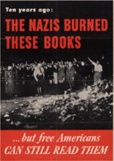
U.S. Government Printing Office, Ten years ago the Nazis burned these books but free Americans can still read them, 1943, poster, 28 x 20 inches, Minneapolis Public Library, MN.
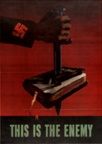
U. S. Office of War Information, and U. S. Government Printing Office, THIS IS THE ENEMY, 1943, 40 x 28.5 inches, Minneapolis Public Library, MN.
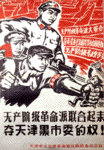
China, Three Against the Enemy, poster from the People's
Republic of China's period known as the Cultural revolution,
1966-1976, Burke Museum, U of WA, Seattle.

China, Schoolchildren devote themselves to Mao's writings,
poster from the
People's Republic of China's
period known as the Cultural revolution, 1966-1976, Burke Museum,
U of WA, Seattle.
Jenny Holzer (American, 1950-), Truisms, 1983, computerized electronic sign, 6 5/16 x 60 1/2 x 4 1/4 inches (16 x 153.7 x 10.8 cm), Museum of Contemporary Art, Chicago, IL. "Truisms is a series of 193 one-line statements which appear either as printed signs or, as here, computer-generated graphics." One of these statements is, "There's a fine line between information and propaganda." See conceptual art.
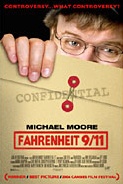
![]()

Michael Moore (American, contemporary), director and narrator, Fahrenheit 9/11, 2004, 35 mm film, c. 110 minutes. Moore's Web site calls it a "searing examination of the Bush administration's actions in the wake of the tragic events of 9/11." This and others of Moore's movies are sometimes called documentary films. But makers of "documentary" works are generally expected to be as objective as possible, and Moore is unappologetic about shaping his works (by his choice of interviewees, questions to them, narrative, and editing) in supporting his opinions. His films might be called editorials, polemics, or diatribes, but they have also been called propaganda. At least in part, this is because others have promoted Moore's films to pursuade audiences to take these opinions. Considering the unpleasant connotations attached to the word "propaganda," people who enjoy such works generally prefer to categorize Moore's films as documentary rather than propaganda, wishing to give these films the most positive spin possible.
![]()
Also see advertising, agitprop, broadside, fascist aesthetic, graphic design, handbill, socialist realism, and subliminal message.
https://inform.quest/_art